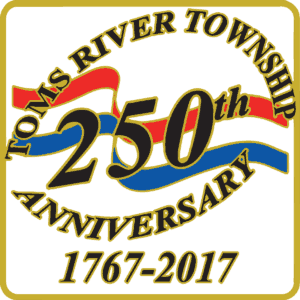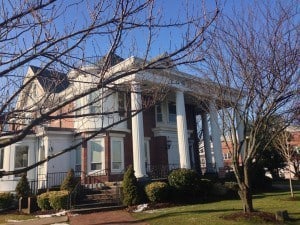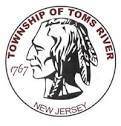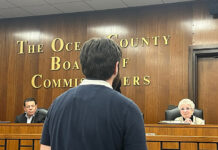
TOMS RIVER – Before history books were written, much of history was passed through oral tradition. And that was also the case at the Toms River Talks event, where several residents with deep roots in the town spoke about what it was like to grow up here decades ago.
Several lifelong residents spoke about growing up in town, and what life was like back then. It was moderated by veteran reporter Don Bennett. It was one of a series of events that mark the town’s 250th anniversary.
Toms River Township Clerk J. Mark Mutter opened the event by declaring that the story of Toms River is a story of “diversity, resiliency, and the human spirit.”
 He spoke of the earliest settlers, the Lenni Lenape, and how one early explorer married into the tribe.
He spoke of the earliest settlers, the Lenni Lenape, and how one early explorer married into the tribe.
The first reference to “Tom’s River” is on a British colonial map, he said. The town was formed by royal assembly, a democratically elected body, forged from the region and made into a town 250 years ago. This made it nine years older than the United States.
As a significant place of business, and piracy, it was targeted by the British, and burned almost completely to the ground. Mutter noted that Toms River then rose from devastation to become the county seat of a new county.
Himself a historian, Mutter asked the panel about how the township reacted to V-J Day and the assassination of John F. Kennedy. The panelists shared information about public assemblies that were held, but a few of them were still overseas for V-J Day.
Mostly, the panelists discussed the community aspect of the town.
Long-time resident Barbara Carlino said she grew up in Toms River in the 1930s during the Great Depression. Still, “Toms River had anything you wanted and anything you needed.”
Carlino had been an administrative secretary for the Toms River schools for 45 years.
She counted off the stores that existed, and where you went for whatever you needed. She noted that the library used to be just two rooms above a store.
“Everybody was so congenial. Everybody knew everybody else,” she said.
Dave Johnson was co-publisher of the Ocean County Sun. He said 80 percent of the stores were owned by people who lived in town. He agreed that the town used to be a place where everyone knew everyone else.
“Today, I can walk down the street and no one would know me and there’s no reason to know me,” he said.
People also used to identify with sections of town. They might not say “I’m from Toms River,” but “I’m from Pleasant Plains.”
- Manuel Hirschblond is a lifelong resident, who worked for Walter Reade Theatres and was the clerk/administrator for Dover Township. His father operated the original TRACO theater downtown. It was a neighborly hangout, where everyone would go and talk, then have an ice cream soda next door. It went through different periods, like vaudeville and silent movies. He even said that Abbott and Costello told their famous “Who’s On First” routine there. His father paid them $15 for three shows.
“The TRACO theater in its heyday was a jewel where people would congregate,” he said.
There was a drive-in theater on Route 37, which is where the Kmart now is.
Milk delivery came by horse-drawn wagon, and 400 students all went to one high school.
“We never locked our door at night. We could leave our bicycle by the back door all night.”
A lot changed in the 1960s, as the population swelled.
Mutter called the opening of the Garden State Parkway interchange in 1954 as the seminal event of the 20th Century for the town. By way of comparison, the population in 1950 was 7,700. In 1960, it was 17,000. By 1970, it had grown to 43,000.
“Sometimes, our local officials didn’t make the right decisions,” he said of some of the development.
Bennett, whose father, John, had been superintendent of Toms River schools, noted that the school population grew as well. There were 3,000 students in 1956. It was 5,000 in 1960, and 17,000 in 1977.
“A lot of things went on that shouldn’t have,” Hirschblond said about development. It’s become a city, now that it has 91,000 year-round residents, and 125,000 in the summer.

“We had growing pains in this town. Little stores couldn’t make it,” Johnson said. There was a lot of turnover downtown in stores. There was also a parking problem.
Still, the younger residents on the panel said they loved the community where they grew up.
Robert Tarver, Jr. is a life-long Toms River and South Toms River resident, who has served as Chief Public Defender for the county, and as a state prosecutor.
“I had a very, very enjoyable childhood,” he said.
As an African-American in a white community, he had some problems, but not in the same way as others might have had. He said he had the ability to be part of the community in a way that he might not have had the opportunity to in another town.
As a football player, under coach Ron Signorino, the town rallied behind the team. He recalled that as the team was undefeated, against Middletown, who was also undefeated, the entire town was rooting for them. When they lost, the entire town was sad.
However, when the schools split up, and more high schools were built, some of that unity was lost, he said.
“The school really fosters community,” he said. There were quality people, who “instilled a sense of character and dignity.”
He recalled heading to Seaside, across a very bumpy Route 37, which still had circles instead of lights.
Caroll Genay Murray, a life-long resident and library staff member, grew up in the downtown area.
“Growing up in Toms River was an excellent, excellent experience because everyone looked after each other,” she said.
She recalled school trips to the dairy farm at Bey Lea, which is now the golf course. She said she learned to drive on the bridge to Seaside. It was only three lanes at the time. Two were one way, and one came back. The driving instructor would make students drive in that middle lane.
Santa Claus would parachute down to the roof of W.T. Grant’s department store, which was located where Kohl’s now is.
 She recalled sledding down Lien Street. Some of the bigger kids would station themselves at the bottom to catch sledders if they got too close to Water Street.
She recalled sledding down Lien Street. Some of the bigger kids would station themselves at the bottom to catch sledders if they got too close to Water Street.
The panelists shared details from their lives, sometimes as a fun aside, sometimes with great emotion. They talked about where kids went for fun, and how they got in trouble with their parents. They talked about swimming in the river, until it was polluted by Toms River Chemical, or Ciba-Geigy. They talked about locations and people who have since come and gone.
This oral history was recorded by a film crew from Ocean County College. There were roughly 60 members of the audience. They were asked to write down their memories of Toms River for inclusion in a book, that would take these memories and record them permanently.






